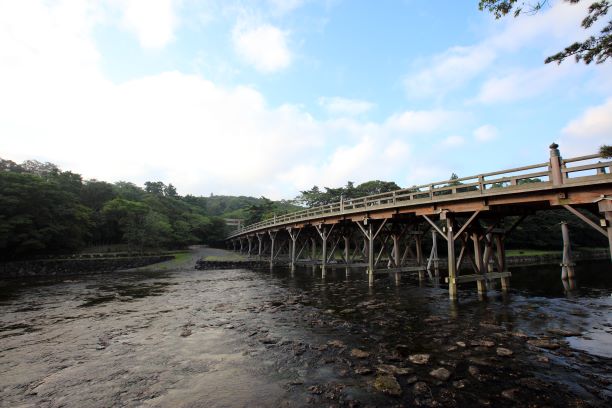“The Soul of Japan” – 伊勢神宮 Ise Jingu
‘Ise Grand Shrine,’ or Ise Jingu holds a very special place in the hearts of the Japanese people. Ise Jingu is the oldest and most sacred Shinto Shrine in Japan. One of Japan’s most sacred sites, where the Sun Goddess Amaterasu Omikami resides.
Ise Jingu Shrine covers an area of over 500 square kilometers, with over 1500 rituals conducted on Ise Shima annually, to pray for the peace and prosperity of the Imperial Family and the Japanese People.
All buildings and monuments at Ise Jingu are rebuilt every 20 years over at least the last 1300 years. This continuous rebuilding plays an important role in the transfer of technical skills, spirit and devotion to Japan’s cultural heritage from one generation to the next. As of today, over 62 generations of Japan’s great craftsmen and builders have visited these sacred grounds, devoting their decades of experience and knowledge to future generations of craftsmen who have yet to be born.
What makes Ise Jingu such a unique architectural wonder is how it is built in traditional Japanese timber frame construction. Without a single nail, Ise Shrine has withstood so many natural disasters over the last 1300 years.
This continuous re-building serves another very specific purpose. In the course of re-building, Ise Jingu shares pieces of prior construction as divine treasures to be reused at other Shinto Shrines throughout Japan.
Japan is proud to be understood as among the world’s first ‘forest conservationist cultures.’ Wood is central to Japanese civilization and the concept of sustainability and reutilization. Unlike other cultures, Japan is not blessed with extensive natural resources. Because of this, Japan continues to pursue sustainable options like reforestation and technological innovation while maintaining generational sharing of know-how and skills, now and into the future.
The Importance of Ise Jingu
This generational re-building of buildings and structures at Ise Jingu is how the Shinto Faith embraces the dedication of Ise Jingu, a belief system that embraces both human impermanence and eternal time.
5 Major Tenets of the Shinto Tradition
- Purity. We are born on this earth, beautiful and pure in spirit. Through lifes’ adversities, we strive to remain pure and beautiful in spirit to ourselves, our loved ones and each other, the way of the kami.
- Sincerity. ‘Makoto,’ or Sincerity of the Heart. Without sincerity and acts of good faith in our hearts, acts of false intent or purpose are meaningless and more harmful than helpful.
- Harmony with Nature. Seeking harmony with the way of the kami, taking care of the environment is a primary Shinto concept. In the Shinto tradition, a kami is thought of as a living force in a higher dimension. The concept of kami is sometimes applied to spirits that live in things, and it is also applied to the things themselves.
- Festivals. (Matsuri) Shinto Festivals both large and small, celebrated throughout Japan every year,. serve to bind communities together with spectacular and sublime time-honored festivals from one generation to the next.
- Living in the Moment. The Shinto tradition is focused on the present. In the Shinto tradition, life is a celebration of what we know and what we have right now. The Shinto tradition insists on present awareness, versus regrets of the past or anxiety over a future as yet to unfold. The Shinto tradition sees the future as yet to be written. We are the composers of our own lives. Meeting the moments of our lives with preparation is the way of the kami.

常若 “Toko Waka”- The Eternal Youth of the Pearl Industry
Due to climate change and the decline in the number of local pearl farmers, Akoya pearl production has been declining rapidly, now at 1/10th of past production levels. As recently as 2019, 80% of Akoya oysters died due to ocean temperature changes. Of those pearls, even after several years of diligent cultivation, fewer than 30% of harvested cultured pearls can be used for jewelry. Ise Shima covers not only pearl cultivation, but supports harvesting, cleaning, processing, grading and crafting, all of which is still done by hand. The grand tradition of the Japanese pearl industry is alive and well, started and remains in Ise Shima, Japan.
常若 “Toko Waka” – As we can see “Eternal Youth” and “The Eternity” of Ise Jingu, we wish to pass on this great tradition and the art of our Japanese pearl jewelry to future generations.
Ise Jingu Is The Most Sacred Shrine In Japan
Japanese people continue to worship the Sun Goddess, Amaterasu OmiKami, worshipped as a founder of Japan and Ancestor of the Emperor. It’s the almost same size as Paris, in France. What is less well known is how Ise Jingu is the main hub of the Shinto Faith, comparable in size to the Vatican in Rome Italy, or Mecca in Saudi Arabia. In throughout the year, people from all over Japan, including Japan’s Prime Minister and Members of the Japanese Royal Family visit Ise Shrine annually.
If You Want To Experience History, Culture, Beautiful Scenery And Of Course Great Food, Ise Shima Has It All.
Ise Jingu (A National Heritage Site), pearl rafts, and female divers known as “ama,” dive for abalone and turban shells – of course to eat! And don’t forget Matsusaka Beef, the most famous beef in Japan as yet to be exported, which only enhances its value.
This exquisite balance between the natural landscape and the rich cultural history makes Ise Shima uniquely appealing. We are very much looking forward to your visit to Ise Shima post COVID.

The Bridge for Ise Shrine – Pearl FALCO Ise Gallery
By the way, our Ise Gallery Building was designed by one of the famous artilects in the motif of Uji Bashi (The Bridge for Ise Shrine shown in the above left photo) though we didn’t rebuild yet after 20 years.
There are more than 4000 pearl jewelry and the most of them are one design at time in our Ise Gallery. You will be able to enjoy seeing the difference of each pearl jewelry and deepen your knowledge about pearl with our pearl specialist.
